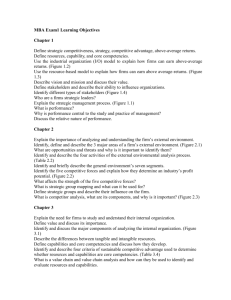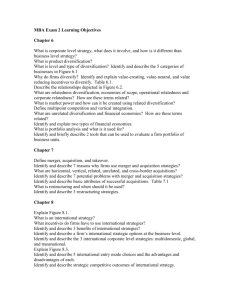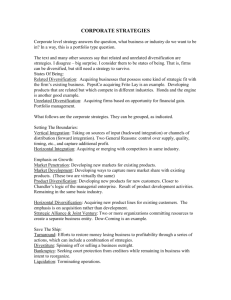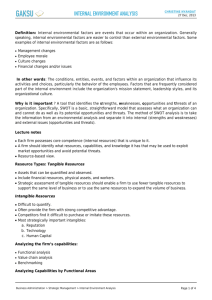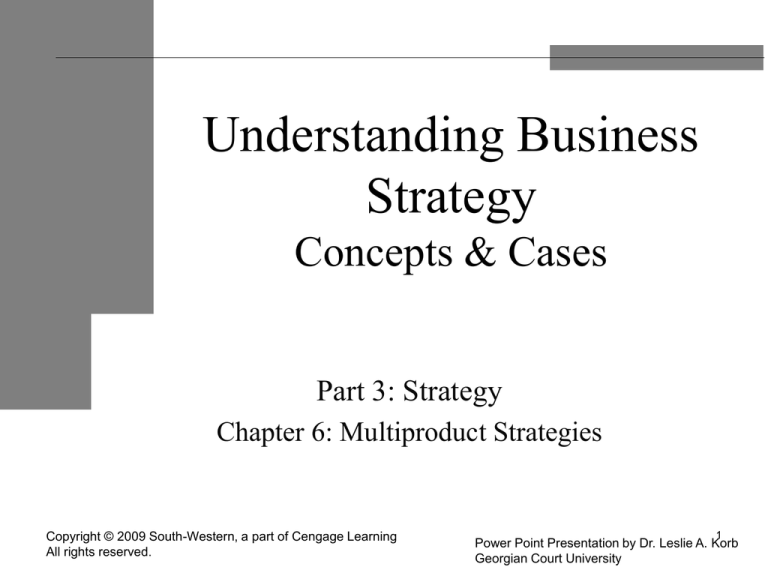
Understanding Business
Strategy
Concepts & Cases
Part 3: Strategy
Chapter 6: Multiproduct Strategies
Copyright © 2009 South-Western, a part of Cengage Learning
All rights reserved.
1
Power Point Presentation by Dr. Leslie A. Korb
Georgian Court University
Multiproduct Strategies
An action plan the firm uses to compete in
different product markets
More diversified
Multiproduct strategies result in performance
improvements when their use allows firms to
create operational relatedness, corporate
relatedness, or financial economies
2
Multiproduct Strategies
What products or services will the firm
produce and sell?
How will the firm manage the different units it
creates to produce and sell its products and
services?
3
4
Levels of Diversification
Five levels
Low levels of diversification
Moderate to High levels of diversification
Single businesses
Dominant businesses
Related constrained
Related linked
Very High levels of diversification
Unrelated
5
6
Single Business Multiproduct
Strategy
A firm pursuing low levels of diversification
uses the single or a dominant business
multiproduct strategy
The firm generates at least 95 percent of its
sales revenue from a single business
A single business is one in which the firm
makes and sells a single product or service
7
Dominant Business
Multiproduct Strategy
A firm using the dominant business multiproduct
strategy generates between 70 and 95 percent of its
sales revenue from a single product group
UPS
Achieving additional successes in different product
markets may cause a firm to become more
diversified
Changing the multiproduct strategy a firm is using
signals a need to change the organizational
structure in place
8
Moderate to High Levels of
Diversification
Related Diversification
Firms using a related diversification
multiproduct strategy try to create economies
of scope
With the related constrained multiproduct
strategy, the firms’ businesses are related to
each other
In the related linked diversification strategy,
only limited links or relationships exist
between the firm’s businesses
9
Moderate to High Levels of
Diversification
Resources and activities may be shared
between some of the businesses that are a
part of a firm using the related linked strategy
Corporate-level core competencies
An ability to price the firm’s products and
services effectively is an example of a
corporate-level core competency that can
create economies of scope when transferred
from one of the firm’s businesses to its other
businesses
10
Moderate to High Levels of
Diversification
Unrelated Diversification
A firm that does not try to transfer resources
and activities between its businesses or core
competencies into its businesses
Commonly called conglomerates
Used in developed and emerging markets
11
Moderate to High Levels of
Diversification
Operational relatedness is achieved when the
firm’s businesses successfully share
resources and activities to produce and sell
their products
Corporate relatedness is achieved when
corporate-level core competencies are
successfully transferred into some of the
firm’s businesses
12
13
Operational Relatedness &
Related Constrained
Economies of scope are created through
operational relatedness when the firm
successfully shares primarily tangible
resources (such as plant and equipment)
and/or when a primary activity (such as
inventory delivery systems) or a support
activity (such as purchasing procedures) is
successfully used in more than one of its
businesses
Example: P&G
14
Operational Relatedness &
Related Constrained
Risk - the demand for the output of a unit
servicing the needs of several of the firm’s
businesses may fall below the unit’s
production capacity
Risk – not enough sales revenue is
generated to cover fixed costs
15
Corporate Relatedness &
Related Linked
Economies of scope are generated through
corporate relatedness when the firm
successfully transfers corporate-level core
competencies into its different businesses
Example: SBUs and General Electric
16
Operational and Corporate
Relatedness
It is difficult for firms to achieve operational
and corporate relatedness simultaneously
Firms able to do so have developed a
competitive advantage that is difficult for
competitors to imitate
Example: Walt Disney Studios
17
Unrelated Diversification
The unrelated diversification multiproduct
strategy do not emphasize operational
relatedness or corporate relatedness as a
means of creating economies of scope
Financial economies are cost savings or
higher returns generated when the firm
effectively allocates its financial resources
based on investments inside or outside the
firm
18
Efficient Internal Capital
Market Allocation
Efficiency - investors take an equity position
in firms by purchasing shares of stock in
companies they believe have high future cash
flow value
Efficient markets allocate capital in the form
of debt as shareholders and debt holders
seek to improve the value of their investments
by taking stakes in firms they believe have
high growth and profitability prospects
19
Efficient Internal Capital
Market Allocation
Access to information is the main reason
internal capital market allocations in firms
may be the basis for superior returns to
shareholders
Those evaluating the performance of all of a
firm’s divisions can internally discipline poorly
performing units by allocating fewer or
different types of resources
20
Efficient Internal Capital
Market Allocation
The external capital market relies on
information produced by the firm to estimate
the organization’s ability to generate
attractive future revenue and earnings
streams
Firms may not want to divulge additional
information when using these media because
it might help competitors
21
Restructuring
To denote that changes are made regarding
the assets of a firm by buying some or all of
another company’s assets
Buys assets because it believes those assets
would create more value if they were operated
under its ownership
A firm buys another company’s assets with the
intention of selling them as soon as it finds
ways to make the assets more productive
22
Managerial Motives
Reducing the risk of losing their job is the first
motive for top-level executives
Additional diversification reduces the chance
that top-level executives of a diversified firm
will lose their job
The relationship between firm size and
executive compensation is the second
managerial diversification motive
23
Implementing Multiproduct
Strategies
The M-form is the structure of choice for firms with
moderate to high levels of product diversification
The cooperative M-form is an organizational structure
in which horizontal integration is used so that
divisions can share resources and activities
The strategic business unit (SBU) M-form is an
organizational structure in which corporate
headquarters personnel try to transfer corporate-level
core competencies
24
25
26
27
28
Implementing Multiproduct
Strategies
Firms using the unrelated diversification multiproduct
strategy adopt the competitive M-form structure
Divisions operating in a competitive M-form structure
actually compete against one another for the firm’s
resources
Examples: Textron and Sears Holding Company
29


